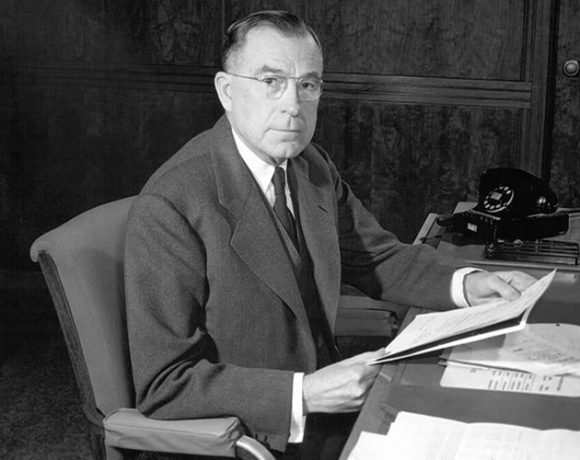How did 3M survive bankruptcy and become a world giant?
Founded with the name Minnesota Mining and Manufacturing, that is, the name starting with 3 M, the first job of this company was to produce sandpaper. Then what happened that changed the field? Who founded it, how did it grow? The answers are in this article:

William McKnight, who started as an accountant at 3M in 1907, took over the company in 1929. William McKnight, who has successfully led 3M for 37 years, has a very special place in 3M history. He brought the company back from the brink of bankruptcy with the projects it developed in 3M's most difficult times. In addition to being a good manager, McKnight has managed to set an example for countless entrepreneurs with his own management philosophy.
Briefly by William McKnight
William McKnight was born on November 11, 1887, in White, South Dakota, USA, as the third child of Joseph and Cordelia McKnight. While continuing his education at Duluth Business University in 1907, he started working as an accountant at 3M for $11.55 a week. 3M, which started operations in 1905, was established to find minerals for use in millstone abrasives. But 5 joint businessmen went bankrupt because they failed. The full name of the company was Minnesota Mining and Manufacturing. So a name consisting of 3 M's. After the bankruptcy, they wanted to go into the sandpaper business. But the company's financial structure was very weak.
Examining the company's finances and payment plans, William McKnight thought that the problem could not be solved simply by finding funds. He shared his ideas and views on developing better products and reducing costs with the management. Although he was still a university student, the innovative solution proposals he developed attracted the attention of the company management. The suggestions he developed to save the company from bankruptcy, as well as the attention and care he showed to his job, gave the clues that William McKnight would achieve a rapid rise within 3M.
William McKnight, who received the support of the company management in a short time, was promoted to cost accountant before accounting staff. He was later appointed head of the company's Chicago office. McKnight's ascent at 3M continued in 1914 as general manager. In addition to his work discipline and meticulousness, the right forms of communication with employees at all levels are the company's St. At its headquarters in St. Paul, it increased admiration for McKnight. With the synergy it created, 3M reduced its production costs, diversified its financial resources and avoided bankruptcy.
A 29-year-old vice president…

Investors who funded 3M under McKnight's management saw that the minerals obtained from the shores of Lake Superior, especially anorthosite, were very durable and believed that it would make a difference in abrasives used in furniture production. The abrasives produced by 3M using anorthosite were more economical and higher quality than the garnet used in abrasives until then. Increasing demand in the market was a new opportunity for William McKnight and 3M. But the company did not have enough capital to increase its production capacity. Thereupon, McKnight resorted to borrowing in addition to the funds provided by investors and increased the number of employees.
With new names joining the team, 3M developed new abrasives combining carbon and silicon and continued to increase its market strength. Liberal policies implemented in the USA during this period when Europe was struggling with economic, political and humanitarian problems with the effects of World War I, led to the emergence of relentless competition in all markets. While many companies were going bankrupt in this competitive environment, under McKnight's management, 3M managed to increase its product variety and keep prices low, and it had a great power against its competitors. Thanks to these achievements, McKnight was appointed vice president of 3M in 1916.
3M's R&D center, 1920s...
This rise, which William McKnight achieved at the age of 29, brought with it new responsibilities. Moreover, 3M's president, Edgar Ober, turned over his powers to McKnight because he fell ill, and McKnight took over the de facto management of the company. In the fiercely competitive environment in the US markets, the most important problem McKnight had to overcome was finding financial support for the new investments that needed to be made to grow 3M. It was no longer possible to finance investments through borrowing as the interest rates rose in the war environment. That's why McKnight developed a new supply chain management for 3M and was able to finance new investments.
The presidency that came during the Great Depression…
Although 3M has been de facto managed by William McKnight since 1916, in 1929 McKnight was officially appointed president of 3M. During this period, 3M further developed abrasive products used in furniture production and opened to world markets. Wetordry abrasives, patented in 1921, were met with great interest in the world market. Special masking tapes introduced in the second half of the 1920s accelerated the rise of 3M in the world market. However, the Great Depression experienced at the time of McKnight's presidency of 3M shook the world economies deeply and, like many US companies, 3M was adversely affected by the contraction in demand in the market.
The 1930s were tough for William McKnight and 3M. But it also brought new opportunities. The sales success achieved in masking tapes enabled 3M to intensify its R&D efforts on adhesives. During these studies, important innovative solutions were developed for cellophane tapes. Especially the new type of cellophane tapes developed for transparent surfaces attracted great attention in the sector. Industrial tapes and adhesives produced until that time did not have suitable properties for use on transparent surfaces. The new type of cellophane tapes developed by 3M provided a perfect adhesion on transparent surfaces and did not damage the surfaces. In this period, when the effects of the Great Depression were felt in all world markets, cellophane tapes offered to the market under the Scotch brand became the ideal solution for repairing torn book pages and documents.
In the 1930s, 3M began to focus on different fields.
New Brands and Growth in Europe
In the interwar period, defense investments were increasing both in Europe and the USA. During this period, William McKnight wanted to overcome the crisis period with the least damage by developing products for the defense industry. Reflective materials used in highway markers included in 3M's product range were introduced to the market under the Scotchlite brand. In the 1940s, the product range of the Scotchlite brand increased rapidly. Thanks to the reflective foils, sound recording tapes and filament tapes developed, 3M regained the strength it had in the American market before the Great Depression and started to expand into the European market.
In the post-World War II period, Europe needed large investments in almost every field and provided investment support to American companies. William McKnight decided to focus 3M's investment priorities in this period on technology and cleaning products. Thanks to these investments aimed at meeting the needs of Europe, which is experiencing the worst devastation of the war, 3M strengthened its power in the European market. In the technology group, copiers, video tape and overhead projector systems and magnetic tapes attracted more attention. Introduced in 1947, sound recorders inspired major innovations in the music and entertainment industry. The Scotch-Brite brand, which offered cleaning products to the market, had a high market share for cleaning cloths in industrial areas.
In the 1950s, 3M continued to increase its product range and create new brands in many different fields, in addition to technology and cleaning products. Developed in accordance with the needs of the market, these products and brands enabled the company to acquire new investors in Europe. William McKnight, who officially assumed his presidency in 1929 and continued uninterruptedly until 1966, had turned the company, which he started as an accountant when it was a small mining venture, into a multinational company. William McKnight, who was the honorary president of the company until 1972, died in 1978. The McKnight Foundation, which he founded in 1953, continues to support young entrepreneurs in many parts of the world.
After World War II, 3M grew rapidly in the European market.
William McKnight's Management Philosophy
During his tenure at 3M, William McKnight has successfully implemented a management philosophy that encourages employees to take responsibility and use their initiative. This understanding, which is still applied at 3M today, has set an example for multinational companies. As a matter of fact, as the business grows, it becomes difficult to manage the entire structure from a single center. At this point, William McKnight believed that senior managers should have a high culture of tolerance. He thought that all employees and mid-level managers would seek and find the best for their company, and even if they made mistakes in any matter, mistakes would benefit the company in the long run with the right interventions.
According to William McKnight, the main task of senior managers was to determine the goals of the company and to effectively evaluate all possibilities to achieve these goals. Managers who develop employees' problem-solving skills and encourage them to take initiative can achieve these goals more easily. A manager profile that interferes in everything and even dictates how to do things may seem useful in the short term, but it kills the entrepreneurship and innovation spirit of the company in the medium and long term, weakens the problem-solving skills of the internal mechanisms and leads to loss of effort and time.
Correct communication styles are of great importance in William McKnight's management philosophy. Believing that communication between employees and managers strengthens internal ties, develops a sense of belonging and fosters a sense of achieving common goals, McKnight said in his speeches with both managers and employees, "Don't hesitate to emphasize how much you depend on each other." For McKnight, the right forms of communication were one of the key elements that strengthened the company's spirit of entrepreneurship and innovation.
In his 59-year career, William McKnight succeeded in making 3M a world giant.
McKnight also believed that the way to success is through taking risks, controlled and sustainable growth, analyzing market needs correctly, learning from mistakes, taking the right steps at the right time, and not losing hope for the future. In his 59-year career at 3M, William McKnight has successfully applied this philosophy and left a world giant behind.

